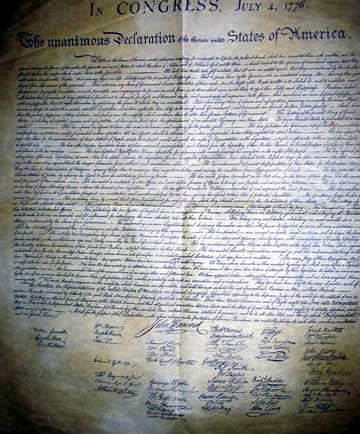 by Preston MacDougall July 03, 2006
Should small-talk shift from the weather to politics, I am worried that July 4th fireworks might come a bit early this year. To defuse this situation, I suggest that, for this year anyway, we celebrate Independence Day with a slightly different spelling: Independents' Day.
This would be just as historically accurate, since the signers of the Declaration of Independence were all Independents, as far as I can tell. Political parties were a fact of life in the Kingdom that we "dissolved political bands" with in 1776. For instance, the Tories were a 17th century political faction that formed in the Kingdom of Great Britain over the terms for succession to the throne. Members of the conservative parties in Canada and Britain are affectionately (or not) referred to as "Tories" to this day. I suppose that many of the 56 signers of the Declaration of Independence had political leanings one way or another. After all, many of the examples of the "tyranny" of King George III, which are cited in the Declaration, involve legislative matters such as taxes and foreign policy. Political alliances form and dissolve all the time. However, it seems that breaking up is harder to do. They did though, break up that is, and when I recently visited Constitution Gardens in Washington DC (just north of the Reflecting Pool in the National Mall). I noticed that something was missing among the 56 signatures to the infamous "Dear George" letter. Parenthetically, if you haven't been to Constitution Gardens, enlarged replicas of the Declaration's signatures are carved in big stone blocks that can serve as benches beside a tree-lined pond in a part of the Mall that I found surprisingly lacking in tourists. It was just me and some Canada geese - perhaps they were feathered tourists. If they were, judging by the offerings left by the signed stones, they must have been Tories, descended from Loyalist geese that migrated north, instead of south, in the summer of 1776. But it wasn't only tourists that were missing. Also missing were parenthetic identifiers, such as (Tory) or (Whig), after the signatures. There were a couple of "Jr."s, a proud "of Carrollton" after Charles Carroll's signature, not to mention some famous flare underneath John Hancock's John Hancock. But no hint of political parties. Did they know something that we have forgotten? We do know how at least one signer felt. In 1789, Thomas Jefferson wrote: "I am not a Federalist because I never submitted the whole system of my opinions to the creed of any party of men, whether in religion, in philosophy, in politics, or anything else. If I could not go to Heaven but with a party, I would not go there at all." Nowadays, of course, the parenthetic identifiers (R) and (D) are stamped on virtually everything political. In some ways, the political division of the country reminds me of the Periodic Table of the Elements (not to be confused with the Periodic Table of the Elephants, a creative project of students at Patapsco High School and Center for the Arts in Baltimore County). One way that chemists divide the periodic table is into two broad regions: metals and non-metals. Elements that are on the fence, such as silicon, are called metalloids, and they form a zigzagging diagonal line from boron (around Minneapolis) down and over to astatine (near Atlanta). Metals are on the left and non-metals are on the right. On most periodic tables, hydrogen, a non-metal, is at the top-left corner and is thus misplaced in this regard. Although, recent laboratory experiments have shown that under the enormous pressures that would be experienced at the heart of gas giant planets such as Jupiter and Saturn, hydrogen hops the fence and behaves metallically. Astronomers believe this explains the large magnetic fields around these planets, much like iron in Earth's core, with the help of a compass, can now direct you from the Reflecting Pool to Constitution Gardens, without a map. Dividing the elements into metals and non-metals, with a few metalloids in between, is simple and convenient, but it is practically useless if one wants to construct something functional, like a catalyst for change. That is why, if you look at a chemist's workbench, on any periodic table that has signs of frequent use, each element's square is jam-packed with symbols and numbers that tell a chemist some key chemical characteristics of that element. This kind of information, with the training of a chemical education (and a little luck), can direct a chemist on a synthetic path that leads to a catalyst instead of crud. Similarly, I think our country's political path forward will have fewer zigzags, and less crud, if we disregard the parenthetic identifiers and concentrate on who we are as independent elements of America.
On the Web:
Publish A Letter on SitNews Read Letters/Opinions Submit A Letter to the Editor
|
||
